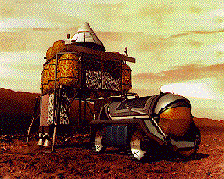 A
Crewed Mission to Mars...
A
Crewed Mission to Mars... A
Crewed Mission to Mars...
A
Crewed Mission to Mars...
 Is it really possible ?
Is it really possible ?
The logistics of a crewed mission to Mars are complex to say the least. Before setting out into the solar system on our way to the Red Planet, there are a seemingly endless number of factors to take into consideration. These factors range from transit vehicles and trajectories, to crew safety and stay-times, to required resources and equipment, and much, much more. Every aspect of mission requirements must be investigated in fine detail before departure because, due to the nature of the flight trajectory, there will be no quick return to, or supplementary supply from, Earth in the event of the unexpected. Upon Earth departure, the crew must be completely self-sufficient, flexible enough to adapt to new situations, and they will undoubtedly require expertise in a wide range of disciplines. A landing site must be chosen, mission objectives must be defined, and a commitment must be made.
The commitment to a human Mars exploration program
would certainly be an ambitious undertaking. A crewed mission to Mars currently
lies on the
 very
edge of our technological ability and the realization of this ambition
(as well as other space science projects) would undoubtedly stand as a
testament to the possibilities which technology presents to our civilization.
Such a mission would give us a more complete understanding of Mars than
ever before which would then, in turn, provide us with a more complete
understanding of the processes and evolution of our own planet.
very
edge of our technological ability and the realization of this ambition
(as well as other space science projects) would undoubtedly stand as a
testament to the possibilities which technology presents to our civilization.
Such a mission would give us a more complete understanding of Mars than
ever before which would then, in turn, provide us with a more complete
understanding of the processes and evolution of our own planet.
A crewed mission to Mars would define a new frontier of human exploration both scientifically and philosophically. The human exploration of Mars raises valid scientific questions of interplanetary biological contamination which must be addressed before the departure of a crewed mission. Furthermore, philosophical issues pertaining to our interference with the natural evolution of another planet must also be resolved. Indeed, especially if a crewed mission to Mars is a precursor to human settlement of the Red Planet, these uncertainties must be thoroughly investigated by the visionaries who strive to implement a human Mars exploration program.
The following pages are a summary of the suggestions and recommendations made by NASA Special Publication #6107 -- Human Exploration of Mars: The Reference Mission of the NASA Mars Exploration Study Team. Additional comments and observations have been included by the author of this site. Note that the dates listed here are taken from the report, which was published in 1997, and are for reference only to illustrate a feasible scenario, no actual mission is planned for these dates.
![]() Crewed Mars Mission Details:
Crewed Mars Mission Details:
![]() Why Go to Mars? - motivations behind a human Mars exploration program
Why Go to Mars? - motivations behind a human Mars exploration program
![]() Mission Objectives and Profiles - objectives, risk evaluation, trajectories,
travel/stay times, split mission strategy
Mission Objectives and Profiles - objectives, risk evaluation, trajectories,
travel/stay times, split mission strategy
![]() Launching the Mission - propulsion, launch schedule, launch payloads
Launching the Mission - propulsion, launch schedule, launch payloads
![]() Landing on the Martian Surface - entry & landing, surface equipment,
surface operations
Landing on the Martian Surface - entry & landing, surface equipment,
surface operations
![]() Surface Systems - power, return propellant production, surface life support
Surface Systems - power, return propellant production, surface life support
![]() Return to Earth - ascent from the Mars surface, Earth Return Vehicle
Return to Earth - ascent from the Mars surface, Earth Return Vehicle
![]() Back to Mars Exploration Homepage
Back to Mars Exploration Homepage
![]() The Full Reference Mission of the NASA Mars Exploration Study Team Report Online - PDF Format (7500 K)
The Full Reference Mission of the NASA Mars Exploration Study Team Report Online - PDF Format (7500 K)
![]() Addendum to the Reference Mission of the NASA Mars Exploration Study Team Report - 1998
Addendum to the Reference Mission of the NASA Mars Exploration Study Team Report - 1998
![]() NSSDCA Planetary Science Homepage
NSSDCA Planetary Science Homepage
 Author/Curator:
Author/Curator: